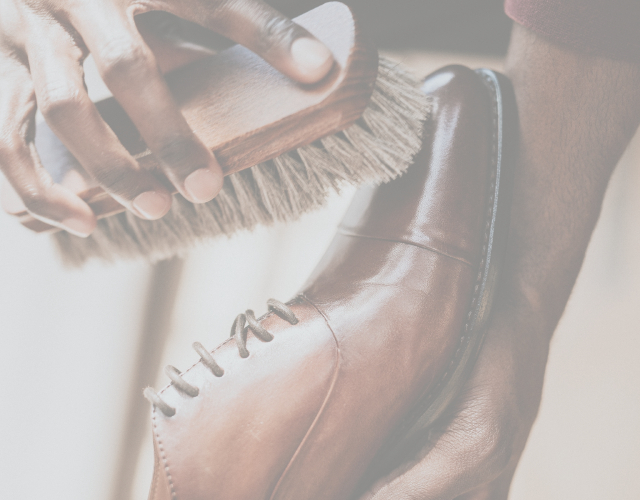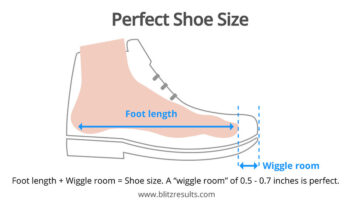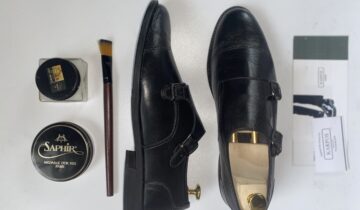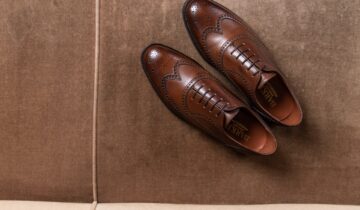Proper leather shoe treatment not only makes your shoes look good, but it also preserves the natural material, adding to their life. Without proper conditioning and care, leather dries out, eventually cracking and falling apart, leaving your shoes and boots an unsightly mess. Throwing a coat of shoe polish on them now again does help. But in order to maintain the supple appearance of your leather goods, you must keep them clean, conditioned, polished, and weatherproofed.
Most of the products used for proper leather shoe treatment can be found at a hardware store, a shoe store, or a shoe repair shop. Make sure to buy products made for smooth leather, as opposed to those used on suede or nubuck. If this makes you nervous that you might mess something up, any shoe repair shop will be happy to clean, polish, and condition your shoes for a price.
For a DIY shoe-care session, you will need the following items:
- Newspaper
- Gloves
- Soft cotton cloth or chamois
- Soft shoe brush
- Smooth leather shoe cleaner
- Leather conditioner for smooth leather shoes
- Shoe polish or an alternative
- Leather protectant or waterproofing product
Cleaning Smooth Leather Shoes
Before you begin, make sure both you and your work surface are amply protected. Layout your newspaper, wear gloves, and work in a well-ventilated space. These precautions are essential, as many shoe care products contain toxic chemicals that can be harmful to both humans and furniture.
First, remove any dirt by cleaning your shoes with leather cleaner made specifically for smooth leather (saddle soap works well). Use the applicator top to spread the product onto your shoes. Next, remove the dirt from the surface of your shoes using your soft bristle brush and paying special attention to the cracks and crevices. After the initial cleaning, let your shoes dry before shining them with your chamois or cloth (old t-shirts work great, too).
Conditioning Leather Shoes
Conditioning your leather shoes softens and moisturizes the membrane, protecting it from drying out and cracking. To do this, first select a conditioner made for smooth leather shoes. (Note: Natural conditioners absorb straight into the material and are a better choice than synthetic conditioners that sit on top of the shoe’s surface.) Rub a small amount of conditioner onto the shoe until the entire shoe is covered. Wait a few minutes, and then wipe any remaining conditioner off of the shoes. The leather will absorb only what it needs to for proper hydration.
Polishing Leather Shoes with Traditional Shoe Polish
Shoe polishes are available in liquids, creams, or pastes. Liquid shoe polish dries quickly, but the colors are limited, as is its durability. Shoe polish paste lasts longer, but it’s messy and slow to work with. So, opt for shoe polish cream for ease of application, availability of colors, and longer wear.
First, select the appropriate color of polish for your shoes. Shoe polish can be purchased from shoe stores, shoe repair shops, hardware stores, and online retailers. After you’ve selected the correct color, apply the polish to a small, inconspicuous area of the shoe to test and match it. Rub the polish into the shoe with a soft cloth and allow it to dry thoroughly. After the polish is dry, shine your shoes by buffing them with a soft cloth or brush made specifically for shoe shining.
A Note on Shoe Polish Toxicity and Alternatives
Certain shoe polishes contain toxic chemicals that can be inhaled and absorbed through the skin. If you opt to use shoe polish, wear gloves while doing so, work in a well-ventilated area, do not drink alcohol while polishing, as it can increase the effects of chemical irritants, and keep all shoe polish out of the reach of both children and animals.
Shoe polish needs to be handled as a hazardous household substance and discarded properly. Rags or cloths used to polish should be contained, with any residual waste, in a sealed plastic bag and disposed of as you would toxic paints or household chemicals.
And while some polishes claim to be non-toxic, most do not list their ingredients, making it impossible to know what’s safe. So if you want to avoid shoe polish at all costs, take your leather shoes to a repair shop to have them polished for you or use natural alternatives like olive oil or walnut oil. To do so, work a small amount of oil into the shoe and then buff and shine it with a soft cloth or chamois. But again, try a test patch before using oil on the entire shoe.
Protecting Your Leather Shoes
Weatherproofing your leather shoes will protect them from water and other elements that can break down the natural material and shorten the life of your shoes. Different weatherproofing products serve different purposes, so choose wisely. For example, if you spend time in wet or messy conditions and an attractive finish is of little concern to you, choose a beeswax product over a protective spray. Beeswax products place a “shield” on the surface of the shoe or boot, instead of it being absorbed into the grain of the leather. This provides a great barrier against water, but applying it on top of subsequent treatments can alter the appearance of your shoes.
If you actually care about the appearance of the shoe or boot, a spray protectant should do the trick without altering the finish. This type of weatherproofing product is virtually invisible and provides a breathable barrier against mild to moderate wet conditions and dirt. Online retailers sell a large variety of waterproofing products, including those for smooth leather, suede, or nubuck.
Additional Tips for Leather Shoe Care
- If your shoes have layers of polish buildup, use a pre-cleaner before starting your leather shoe treatment.
- Don’t try to change the color of your shoes with a shoe polish. Consult a shoe repair shop for a dye job, if a different shoe color is desired.
- Remove shoelaces before beginning your leather shoe treatment. Laces can be laundered separately or replaced.
- Condition new leather shoes, even before you wear them. This will ensure the best protection from the start and will save you time on future cleanings.
* Note: The instructions above are meant for products made of smooth leather only. For suede or nubuck shoes or boots, please check this post.





